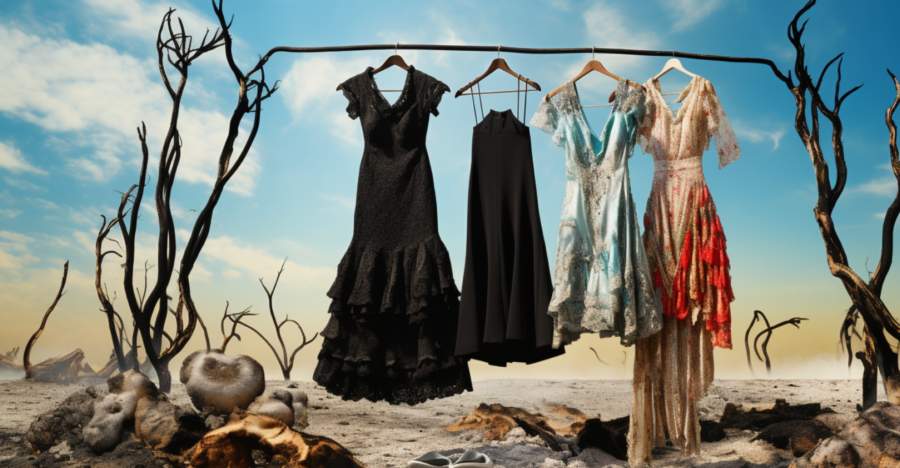The Role of Climate Change in Fashion Trends

Climate Change: The Ultimate Fashion Critic
As it turns out, climate change, that pesky little rascal causing polar ice caps to melt and a bunch of increasingly devastating hurricanes, is quite the fashion critic. It seems to have taken a stern look at our wardrobes and said, "Not good enough, humans. Make it sustainable or face the wrath of sundering storms and rising tides." Who would've thought that the Earth's changing climate would also dictate our clothing choices?The Warming World and Its Wardrobe Malfunction
As global temperatures rise, we're left scratching our heads, pondering what on earth to wear when it's too warm for a winter coat but too chilly for a summer dress. It's like a never-ending game of dress-up, where the seasons are as indecisive as a three-year-old in a candy store. This has led to an interesting phenomenon known as "trans-seasonal" fashion. Think about it: lightweight jackets, versatile boots, and scarves that can be worn as belts or headbands. Fashion's never been so delightfully confused.Fashion Industry: Turning Over a Sustainable Leaf
But fear not, dear clothes horses, because the fashion industry is slowly but surely turning over a new, sustainable leaf. They've realized that if they don't adapt (much like the polar bears they're inadvertently endangering), they'll be left out in the cold (or, more accurately, the sweltering heat). In any case, the industry has begun to take strides in eco-fashion, with an increasing number of brands adopting sustainable practices.- Organic cotton: No more of that pesticide-laden stuff that's harmful to the environment and those who produce it. Organic cotton is all the rage, and the planet is heaving a sigh of relief.
- Recycled materials: Who knew that your old plastic bottles could be turned into fabulous activewear? It's all the rage now, darling. Reduce, reuse, recycle, and look fabulous doing it.
- Slow fashion: It's time to say goodbye to the era of fast fashion—those disposable clothes that are mass-produced at breakneck speed only to be discarded after a few wears. Instead, we're embracing high-quality clothing that is made to last.
Fashion Forward: Sustainable Designers Making Waves
Designers are joining forces with Mother Nature to create chic, eco-friendly clothing, and frankly, it's about time. Here are some of the trailblazers leading the charge in sustainable fashion:- Stella McCartney: A long-time advocate for sustainable fashion, McCartney has been producing animal-free, eco-friendly clothing since the early 2000s. Her collections include organic cotton, recycled polyester, and even mushroom leather. She's the epitome of green chic.
- Patagonia: The outdoor clothing giant has been rocking the sustainable fashion scene for decades. They've got everything from recycled polyester fleeces to fair-trade organic cotton T-shirts. Plus, they donate a portion of their profits to environmental causes. Talk about fashion with a conscience.
- Veja: These sneakers have taken the world by storm, and for good reason. They're stylish, comfortable, and best of all, sustainably made. With fair-trade organic cotton, wild Amazonian rubber, and recycled plastic bottles in the mix, it's hard not to love them.
How You, Too, Can Be a Climate-Conscious Fashionista
So, how can you adapt your wardrobe to the ever-changing whims of climate change? Here are some tips to help you navigate the world of eco-fashion:- Shop less: The first step in becoming a climate-conscious fashionista is to simply consume less. Sure, it might sound counterintuitive for a fashion lover, but think of it as a challenge to get creative with the clothes you already own.
- Invest in quality: When you do shop, opt for high-quality, timeless pieces that will last you many seasons. This way, you're contributing less to the fast-fashion cycle and reducing your overall environmental impact.
- Support sustainable brands: When you need a new wardrobe addition, seek out brands that prioritize eco-friendly practices. You'll feel good knowing that your purchase is helping to support a greener future.
- Dispose responsibly: When it's finally time to part with a beloved piece of clothing, make sure it's disposed of in a responsible manner. Donate, recycle, or repurpose your old garments instead of simply tossing them in the trash.
Article kindly provided by foreverinfashion.org
Latest Articles
- Style That Works With Your Body, Not Against It
- Fashion Tourism on Wheels: Curated Shopping Routes Led by Chauffeur Guides
- The Charm of Certainty in a World of Indecision
- Can an Everyday T-Shirt Be Turned into a Modern Heirloom?
- Color, Ceremony, and the Psychology of Celebration
- Styling Graphic T-Shirts for Different Body Types
- Getting Kids to Wear Their Hats Without a Bribe or a Meltdown
- Mastering the Art of Being the Unnoticed Photographer
- Quiet Sportswear Moves Loudly
- Fashion's Most Misunderstood Color Is Brown
- Weight Matters When Cotton Gets Real
- SKU's Out for Summer: Why Your Warehouse Is Melting Down
- Ink as Accessory - How Tattoos Are Replacing Jewelry in Modern Style
- Decoding the Y2K Aesthetic with Style and Sanity
- Accessories
- Jewellery
- Footwear
- Skirts and Dresses
- Shirts and Blouses
- Beauty and Makeup
- Fashion Photography
- Sustainable Fashion
- Street Style
- Fashion History
- Fashion Business
- Fashion Styling
- Fashion Events
- Plus-Size Fashion
- Men's Fashion
- Women's Fashion
- Fashion Blogging
- Fashion Trends
- Fashion Retailers
- Fashion Tips and Advice
- Fashion Business Startups
- Fashion Around the World
- Lingerie
- Sportswear
- Weddings

